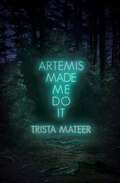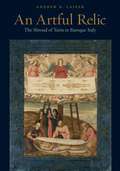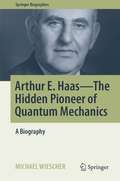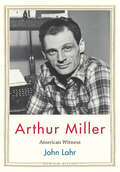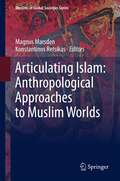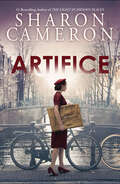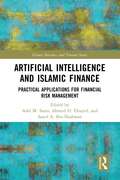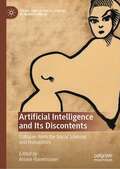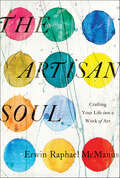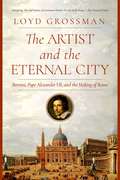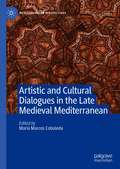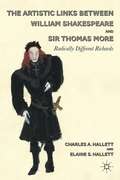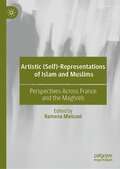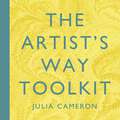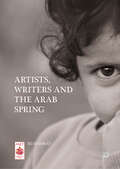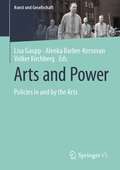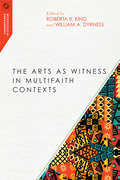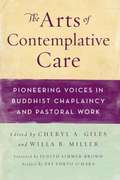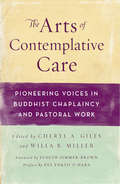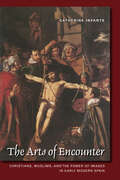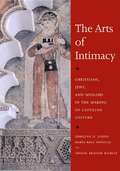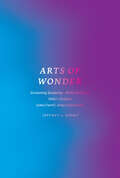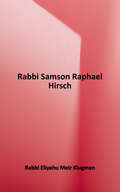- Table View
- List View
Artemis Made Me Do It (Myth and Magick #2)
by Trista MateerBestselling and award-winning author Trista Mateer returns with another magical approach to self-care in her newest goddess-themed poetry collection, Artemis Made Me Do It. Using the framework of tarot and conversation, Mateer approaches myth through a witchcraft-inspired lens and uses it to explore timeless issues like burnout, survival, trauma, and the restorative power in taking control of your own lore. Artemis speaks to what is wild and untamed in all of us, and in this new collection, she asks for a moment of calm. This is the second book in the Myth & Magick series, which also includes Aphrodite Made Me Do It and Persephone Made Me Do It.
An Artful Relic: The Shroud of Turin in Baroque Italy
by Andrew R. CasperIn 1578, a fourteen-foot linen sheet bearing the faint bloodstained imprint of a human corpse was presented to tens of thousands of worshippers in Turin, Italy, as one of the original shrouds used to prepare Jesus Christ’s body for entombment. From that year into the next century, the Shroud of Turin emerged as Christianity’s preeminent religious artifact. In an unprecedented new look, Andrew R. Casper sheds new light on one of the world’s most famous and controversial religious objects.Since the early twentieth century, scores of scientists and forensic investigators have attributed the Shroud’s mysterious images to painterly, natural, or even supernatural forces. Casper, however, shows that this modern opposition of artifice and authenticity does not align with the cloth’s historical conception as an object of religious devotion. Examining the period of the Shroud’s most enthusiastic following, from the late 1500s through the 1600s, he reveals how it came to be considered an artful relic—a divine painting attributed to God’s artistry that contains traces of Christ’s body. Through probing analyses of materials created to perpetuate the Shroud’s cult following—including devotional, historical, and theological treatises as well as printed and painted reproductions—Casper uncovers historicized connections to late Renaissance and Baroque artistic cultures that frame an understanding of the Shroud’s bloodied corporeal impressions as an alloy of material authenticity and divine artifice. This groundbreaking book introduces rich, new material about the Shroud’s emergence as a sacred artifact. It will appeal to art historians specializing in religious and material studies, historians of religion, and to general readers interested in the Shroud of Turin.
An Artful Relic: The Shroud of Turin in Baroque Italy
by Andrew R. CasperWinner of the 2022 Roland H. Bainton Book Prize from the Sixteenth Century Society & ConferenceIn 1578, a fourteen-foot linen sheet bearing the faint bloodstained imprint of a human corpse was presented to tens of thousands of worshippers in Turin, Italy, as one of the original shrouds used to prepare Jesus Christ’s body for entombment. From that year into the next century, the Shroud of Turin emerged as Christianity’s preeminent religious artifact. In an unprecedented new look, Andrew R. Casper sheds new light on one of the world’s most famous and controversial religious objects.Since the early twentieth century, scores of scientists and forensic investigators have attributed the Shroud’s mysterious images to painterly, natural, or even supernatural forces. Casper, however, shows that this modern opposition of artifice and authenticity does not align with the cloth’s historical conception as an object of religious devotion. Examining the period of the Shroud’s most enthusiastic following, from the late 1500s through the 1600s, he reveals how it came to be considered an artful relic—a divine painting attributed to God’s artistry that contains traces of Christ’s body. Through probing analyses of materials created to perpetuate the Shroud’s cult following—including devotional, historical, and theological treatises as well as printed and painted reproductions—Casper uncovers historicized connections to late Renaissance and Baroque artistic cultures that frame an understanding of the Shroud’s bloodied corporeal impressions as an alloy of material authenticity and divine artifice. This groundbreaking book introduces rich, new material about the Shroud’s emergence as a sacred artifact. It will appeal to art historians specializing in religious and material studies, historians of religion, and to general readers interested in the Shroud of Turin.
Arthur E. Haas - The Hidden Pioneer of Quantum Mechanics: A Biography (Springer Biographies)
by Michael WiescherThe book highlights the personal and scientific struggles of Arthur Erich Haas (1884-1941), an Austrian Physicist from a wealthy Jewish middle-class family, whose remarkable accomplishments in a politically hostile but scientifically rewarding environment deserve greater recognition.Haas was a fellow student of both Lise Meitner and Erwin Schrödinger and was also one of the last doctoral students of Ludwig Boltzmann. Following Boltzmann's suicide, Haas was forced to submit a more independent doctoral thesis in which he postulated new approaches in early quantum theory, actually introducing the idea of the Bohr radius before Niels Bohr. It is the lost story of a trailblazer in the fields of quantum mechanics and cosmology, a herald of nuclear energy and applications of modern science. This biography of Haas is based on new and previously unpublished family records and archived material from the Vienna Academy of Science and the University of Notre Dame, which the author has collected over many years. From his analysis of the letters, documents, and photos that rested for nearly a century in family attics and academic archives, Michael Wiescher provides a unique and detailed insight into the life of a gifted Jewish physicist during the first half of the twentieth century. It also sheds light on the scientific developments and thinking of the time. It appeals not only to historians and physicists, but also general readers. All appreciate the record of Haas’ interactions with many of the key figures who helped to found modern physics.
Arthur Miller: American Witness (Jewish Lives)
by John LahrA great theater critic brings twentieth-century playwright Arthur Miller&’s dramatic story to life with bold and revealing new insights &“New Yorker critic Lahr shines in this searching account of the life of playwright Arthur Miller. . . . It&’s a great introduction to a giant of American letters.&”—Publishers Weekly Distinguished theater critic John Lahr brings unique perspective to the life of Arthur Miller (1915–2005), the playwright who almost single-handedly propelled twentieth-century American theater into a new level of cultural sophistication. Organized around the fault lines of Miller&’s life—his family, the Great Depression, the rise of fascism, Elia Kazan and the House Committee on Un-American Activities, Marilyn Monroe, Vietnam, and the rise and fall of Miller&’s role as a public intellectual—this book demonstrates the synergy between Arthur Miller&’s psychology and his plays. Concentrating largely on Miller&’s most prolific decades of the 1940s, 1950s, and 1960s, Lahr probes Miller&’s early playwriting failures; his work writing radio plays during World War II after being rejected for military service; his only novel, Focus; and his succession of award-winning and canonical plays that include All My Sons, Death of a Salesman, and The Crucible, providing an original interpretation of Miller&’s work and his personality.
Articulating Islam: Anthropological Approaches To Muslim Worlds (Muslims in Global Societies Series #6)
by Konstantinos Retsikas Magnus MarsdenThis collection of arresting and innovative chapters applies the techniques of anthropology in analyzing the role played by Islam in the social lives of the world's Muslims. The volume begins with an introduction that sets out a powerful case for a fresh approach to this kind of research, exhorting anthropologists to pause and reflect on when Islam is, and is not, a central feature of their informants' life-worlds and identities. The chapters that follow are written by scholars with long-term, specialist research experience in Muslim societies ranging from Kenya to Pakistan and from Yemen to China: thus they explore and compare Islam's social significance in a variety of settings that are not confined to the Middle East or South Asia alone. The authors assess how helpful current anthropological research is in shedding light on Islam's relationship to contemporary societies. Collectively, the contributors deploy both theoretical and ethnographic analysis of key developments in the anthropology of Islam over the last 30 years, even as they extrapolate their findings to address wider debates over the anthropology of world religions more generally. Crucially, they also tackle the thorny question of how, in the current political context, anthropologists might continue conducting sensitive and nuanced work with Muslim communities. Finally, an afterword by a scholar of Christianity explores the conceptual parallels between the book's key themes and the anthropology of world religions in a broader context. This volume has key contemporary relevance: for example, its conclusions on the fluidity of people's relations with Islam will provide an important counterpoint to many commonly held assumptions about the incontestability of Islam in the public sphere.
Artifice
by Sharon CameronA dramatic story of duplicity and resistance, betrayal and loyalty, set against the backdrop of World War II, by the #1 New York Times bestselling author of The Light in Hidden Places.Isa de Smit was raised in the vibrant, glittering world of her parents’ small art gallery in Amsterdam, a hub of beauty, creativity, and expression, until the Nazi occupation wiped the color from her city’s palette. The “degenerate” art of the Gallery de Smit is confiscated, the artists in hiding or deported, her best friend, Truus, fled to join the shadowy Dutch resistance. And masterpiece by masterpiece, the Nazis are buying and stealing her country’s heritage, feeding the Third Reich’s ravenous appetite for culture and art.So when the unpaid taxes threaten her beloved but empty gallery, Isa decides to make the Nazis pay. She sells them a fake—a Rembrandt copy drawn by her talented father—a sale that sets Isa perilously close to the second most hated class of people in Amsterdam: the collaborators. Isa sells her beautiful forgery to none other than Hitler himself, and on the way to the auction, discovers that Truus is part of a resistance ring to smuggle Jewish babies out of Amsterdam.But Truus cannot save more children without money. A lot of money. And Isa thinks she knows how to get it. One more forgery, a copy of an exquisite Vermeer, and the Nazis will pay for the rescue of the very children they are trying annihilate. To make the sale, though, Isa will need to learn the art of a master forger, before the children can be deported, and before she can be outed as a collaborator. And she finds an unlikely source to help her do it: the young Nazi soldier, a blackmailer and thief of Dutch art, who now says he wants to desert the German army.Yet, worth is not always seen from the surface, and a fake can be difficult to spot. Both in art, and in people. Based on the true stories of Han Van Meegeren, a master art forger who sold fakes to Hermann Goering, and Johann van Hulst, credited with saving 600 Jewish children from death in Amsterdam, Sharon Cameron weaves a gorgeously evocative thriller, simmering with twists, that looks for the forgotten color of beauty, even in an ugly world.Praise for Artifice“War, resistance, and art are Cameron’s canvas; her palette is a balance of trust and perfidy, beauty and defiance, new life and old. Artifice is a vibrantly-hued and many-layered story, exploring our very human inability to spot a fake when we long to believe that the object of all our desire is the real thing.” -- Elizabeth Wein, New York Times bestselling author of Code Name Verity* "Painterly prose...filled with rich intrigue depicts constantly shifting issues of trust in this complex, absorbing tale." -- Publishers Weekly, starred review
Artificial Intelligence and Islamic Finance: Practical Applications for Financial Risk Management (Islamic Business and Finance Series)
by Adel M. SareaThis book provides a systematic overview of the current trends in research relating to the use of artificial intelligence in Islamic financial institutions (IFIs), across all organization of Islamic cooperation (OIC) countries. Artificial Intelligence and Islamic Finance discusses current and potential applications of artificial intelligence (AI) for risk management in Islamic finance. It covers various techniques of risk management, encompassing asset and liability management risk, credit, market, operational, liquidity risk, as well as regulatory and Shariah risk compliance within the financial industry. The authors highlight AI’s ability to combat financial crime such as monitoring trader recklessness, anti-fraud and anti-money laundering, and assert that the capacity of machine learning (ML) to examine large amounts of data allows for greater granular and profound analyses across a variety of Islamic financial products and services. The book concludes with practical limitations around data management policies, transparency, and lack of necessary skill sets within financial institutions. By adopting new methodological approaches steeped in an Islamic economic framework (e.g., analysing FinTech in the context of Shariah principles and Islamic values), it devises practical solutions and generates insightful knowledge, helping readers to understand and explore the role of technological enablers in the Islamic finance industry, such as RegTech and artificial intelligence, in providing better and Shariah-compliant services to customers through digital platforms. The book will attract a wide readership spanning Shariah scholars, academicians, and researchers as well as Islamic financial practitioners and policymakers.
Artificial Intelligence and Its Discontents: Critiques from the Social Sciences and Humanities (Social and Cultural Studies of Robots and AI)
by Ariane HanemaayerOn what basis can we challenge Artificial Intelligence (AI) - its infusion, investment, and implementation across the globe? This book answers this question by drawing on a range of critical approaches from the social sciences and humanities, including posthumanism, ethics and human values, surveillance studies, Black feminism, and other strategies for social and political resistance. The authors analyse timely topics, including bias and language processing, responsibility and machine learning, COVID-19 and AI in health technologies, bio-AI and nanotechnology, digital ethics, AI and the gig economy, representations of AI in literature and culture, and many more. This book is for those who are currently working in the field of AI critique and disruption as well as in AI development and programming. It is also for those who want to learn more about how to doubt, question, challenge, reject, reform and otherwise reprise AI as it been practiced and promoted.
The Artisan Soul: Crafting Your Life into a Work of Art
by Erwin Raphael McManusA national bestselling self-help guide to the creative process from the founder of MOSAIC, an LA-based spiritual community “well-known for its creativity” (Publishers Weekly).In The Artisan Soul, Erwin Raphael McManus, author, thought leader, and founder of MOSAIC in Los Angeles, pens a manifesto for human creativity and the beginning of a new renaissance. McManus not only calls us to reclaim our creative essence but reveals how we can craft our lives into a work of art. There are no shortcuts to quality, and McManus celebrates the spiritual process that can help us discover our true selves.McManus demonstrates that we all carry within us the essence of an artist. We all need to create, to be a part of a process that brings to the world something beautiful, good, and true, in order to allow our souls to come to life. It's not only the quality of the ingredients we use to build our lives that matter, but the care we bring to the process itself. Just like baking artisan bread, it's a process that's crafted over time. And God has something to say about how we craft our lives. With poignant, inspirational stories and insights from art, life, history, and scripture interspersed throughout, McManus walks readers through the process of crafting a life of beauty and wonder.
The Artist and the Eternal City: Bernini, Pope Alexander VII, and The Making of Rome
by Loyd GrossmanThis brilliant vignette of seventeenth-century Rome, its Baroque architecture, and its relationship to the Catholic Church brings to life the friendship between a genius and his patron with an ease of writing that is rare in art history.By 1650, the spiritual and political power of the Catholic Church was shattered. Thanks to the twin blows of the Protestant Reformation and the Thirty Years War, Rome—celebrated both as the Eternal City and Caput Mundi (the head of the world)—had lost its preeminent place in Europe. Then a new Pope, Alexander VII, fired with religious zeal, political guile, and a mania for creating new architecture, determined to restore the prestige of his church by making Rome the key destination for Europe's intellectual, political, and cultural elite. To help him do so, he enlisted the talents of Gianlorenzo Bernini, already celebrated as the most important living artist—no mean feat in the age of Rubens, Rembrandt, and Velazquez.
Artistic and Cultural Dialogues in the Late Medieval Mediterranean (Mediterranean Perspectives)
by María Marcos CobaledaThis book analyses the artistic and cultural legacy of Western Islamic societies and their interactions with Islamic, Christian and Jewish societies in the framework of the late medieval Mediterranean, from a range of multi-disciplinary perspectives. The book, organised in four parts, addresses the Andalusi legacy from its presence in the East and the West; analyses the relations and transfers between Al-Andalus and the artistic productions of the Christian kingdoms of the Iberian Peninsula; explores other manifestations of the Andalusi legacy in the fields of knowledge, construction, identity and religious studies; and reconsiders ornamental transfers and exchanges in artistic manifestations between East and West across the Mediterranean basin.Chapter 2 is open access under a CC BY 4.0 license.
The Artistic Links Between William Shakespeare and Sir Thomas More
by Charles A. Hallett Elaine S. HallettApproaching the subject from a dramaturgical point of view, this investigation differs from anything that has been written about the relationship between Thomas More and William Shakespeare. This book defines, in specific terms, what Shakespeare learned from his study of More's "History"and how he exploited that knowledge to heighten the drama. "
Artistic (Self)-Representations of Islam and Muslims: Perspectives Across France and the Maghreb
by Ramona MieluselArtistic (Self)-Representations of Islam and Muslims: Perspectives Across France and the Maghreb is a collection of essays that explores the question of artistic representation(s)/self-representation(s) of Muslim religious and cultural identity in France, the Maghreb and in/between since the 2000s. The volume offers a plurality of feminine and masculine voices and points of view on cultural Islam (Franco-French, Franco-Maghrebi, Maghrebi), all the while addressing the impact of events like 9/11, the tragic attacks in France in 2015-2016 (Charlie Hebdo, Stade de France, Bataclan, Nice), and the Arab Spring. Taken together, the volume features a transnational and transversal set of artistic voices that are not looking for consensus, but rather invoke dissensus (Rancière) and a full range of expression. A necessary part of that full range of expression is (self)-representations: Muslims representing themselves, though this is no facile (self)-representations, as artists continue to use the properties of the imagination and performance to complexify an easy reading, reductive meaning, or oversimplified interpretation. This interdisciplinary study contributes to the fields of French and Francophone Studies, Humanities and Global/Cultural Studies such as political studies, sociology, political philosophy, literature, cinema, visual arts and media studies with a focus on broadening views on the topic of Islam and Muslim (self)-representations across disciplines.
The Artist's Way Toolkit: How to Use the Creative Practices
by Julia CameronHailed as the Queen of Creativity, Julia Cameron is the authority on artistic life and has brought her wisdom to millions around the world. The four essential, accessible tools she has been famed for over her lifelong career-MorningPages, Artist Dates, Walks and Guidance- have transformed lives. Now, for the first time, they are presented together, along with her readers' most commonly asked questions.Offering a deep dive into each tool, Cameron demonstrates how to set ourselves firmly on path to self-love and creative nourishment. Thanks to the learned experience of a lifetime of teaching and writing about creative recovery, she generously delivers inspiring stories and practices to guide us back to discovery.
Artists, Writers and The Arab Spring (Middle East Today)
by Riad IsmatThe book aims to explore the foresight of prominent Middle Eastern authors and artists who anticipated the Arab Spring, which resulted in demands for change in the repressive and corrupted regimes. Eventually, it led to cracking down on the protests with excessive force, which caused tremendous human suffering, destruction, and also escalation of extreme insurgency. The author analyzes major literary and artistic works from Egypt, Syria and Tunisia, and their political context. This monograph will be helpful to scholars and students in the growing field of Middle Eastern and North African Studies and everyone who is interested in the politics of MENA.
Arts and Power: Policies in and by the Arts (Kunst und Gesellschaft)
by Lisa Gaupp Alenka Barber-Kersovan Volker KirchbergThe focus on concepts of power and domination in societal structures has characterized sociology since its beginnings. Max Weber’s definition of power as “imposing one’s will on others” is still relevant to explaining processes in the arts, whether their production, imagination, communication, distribution, critique or consumption. Domination in the arts is exercised by internal and external rulers through institutionalized social structures and through beliefs about their legitimacy, achieved by defining and shaping art tastes.The complexity of how the arts relate to power arises from the complexity of the policies of artistic production, distribution and consumption—policies which serve to facilitate or hinder an aesthetic object from reaching its intended public. Curators, critics and collectors employ a variety of forms of cultural and artistic communication to mirror and shape the dominant social, economic and political conditions.Arts and Power: Policies in and by the Arts brings together diverse voices who position the societal functions of art in fields of domination and power, of structure and agency—whether they are used to impose hegemonic, totalitarian or unjust goals or to pursue social purposes fostering equal rights and grassroots democracy. The contributions in this volume are exploratory steps towards what we believe can be a more systematic, empirically and theoretically founded sociological debate on the arts and power. And they are an invitation to take further steps.
The Arts as Witness in Multifaith Contexts (Missiological Engagements)
by William A. Dyrness Roberta R. KingIn search of holistic Christian witness, missionaries have increasingly sought to take into account all the dimensions of people's cultural and religious lives—including their songs, dances, dramatic performances, storytelling, and visual arts.
The Arts of Contemplative Care: Pioneering Voices in Buddhist Chaplaincy and Pastoral Work
by Cheryl A. Giles Willa B. MillerPowerful and Life-Affirming, this watershed volume brings together the voices of pioneers in the field of Buddhist contemplative care from hospices and hospitals to colleges, prisons, and the military. Each first-person essay offers a distillation of the wisdom gained over years of experience, and vividly shows the lived experience of each pastoral worker. The stories told here are sure to inspire-whether you are a professional caregiver or are simply called to serve through caregiving. Quite simply, this is a book that can change lives.
The Arts of Contemplative Care: Pioneering Voices in Buddhist Chaplaincy and Pastoral Work
by Cheryl A Giles Judith Simmer-Brown Willa B Miller Pat Enkyo O'HaraPowerful and life-affirming, this watershed volume brings together the voices of pioneers in the field of contemplative care--from hospice and hospitals to colleges, prisons, and the military. Illustrating the day-to-day words and actions of pastoral workers, each first-person essay in this collection offers a distillation of the wisdom gained over years of compassionate experience. The stories told here are sure to inspire--whether you are a professional caregiver or simply feel inclined toward guiding, healing, and comforting roles. If you are inspired to read this book, or even one touching story in it, you just might find yourself inspired to change a life.
The Arts of Contemplative Care
by Willa B Miller Pat Enkyo O'Hara Judith Simmer-Brown Cheryl A GilesPowerful and life-affirming, this watershed volume brings together the voices of pioneers in the field of contemplative care--from hospice and hospitals to colleges, prisons, and the military. Illustrating the day-to-day words and actions of pastoral workers, each first-person essay in this collection offers a distillation of the wisdom gained over years of compassionate experience. The stories told here are sure to inspire--whether you are a professional caregiver or simply feel inclined toward guiding, healing, and comforting roles. If you are inspired to read this book, or even one touching story in it, you just might find yourself inspired to change a life.
The Arts of EncounterThe Arts of Encounter: Christians, Muslims, and the Power of Images in Early Modern Spain (Toronto Iberic)
by Catherine InfanteImages of crosses, the Virgin Mary, and Christ, among other devotional objects, pervaded nearly every aspect of public and private life in early modern Spain, but they were also a point of contention between Christian and Muslim cultures. Writers of narrative fiction, theatre, and poetry were attuned to these debates, and religious imagery played an important role in how early modern writers chose to portray relations between Christians and Muslims. Drawing on a wide variety of literary genres as well as other textual and visual sources – including historical chronicles, travel memoirs, captives’ testimonies, and paintings – Catherine Infante traces the references to religious visual culture and the responses they incited in cross-confessional negotiations. She reveals some of the anxieties about what it meant to belong to different ethnic or religious communities and how these communities interacted with each other within the fluid boundaries of the Mediterranean world. Focusing on the religious image as a point of contact between individuals of diverse beliefs and practices, The Arts of Encounter presents an original and necessary perspective on how Christian-Muslim relations were perceived and conveyed in print.
The Arts of Intimacy: Christians, Jews, and Muslims in the Making of Castilian Culture
by Jerrilynn D. Dodds Abigail Krasner Balbale Maria Rosa MenocalNamed a Book of the Year by the Times Literary Supplement, this lavishly illustrated work explores the vibrant interaction among different and sometimes opposing cultures, and how their contacts with one another transformed them all. It chronicles the tumultuous history of Castile in the wake of the Christian capture of the Islamic city of Tulaytula, now Toledo, in the eleventh century and traces the development of Castilian culture as it was forged in the new intimacy of Christians with the Muslims and Jews they had overcome. The authors paint a portrait of the culture through its arts, architecture, poetry and prose, uniquely combining literary and visual arts. Concentrating on the eleventh and twelfth centuries, the book reveals the extent to which Castilian identity is deeply rooted in the experience of confrontation, interaction, and at times union with Hebrew and Arabic cultures during the first centuries of its creation. Abundantly illustrated, the volume serves as a splendid souvenir of southern Spain; beautifully written, it illuminates a culture deeply enriched by others.
Arts of Wonder: Enchanting Secularity—Walter De Maria, Diller + Scofidio, James Turrell, Andy Goldsworthy (Religion And Postmodernism Ser.)
by Jeffrey L. Kosky“The fate of our times is characterized by rationalization and intellectualization and, above all, by ‘the disenchantment of the world.’” Max Weber’s statement remains a dominant interpretation of the modern condition: the increasing capabilities of knowledge and science have banished mysteries, leaving a world that can be mastered technically and intellectually. And though this idea seems empowering, many people have become disenchanted with modern disenchantment. Using intimate encounters with works of art to explore disenchantment and the possibilities of re-enchantment, Arts of Wonder addresses questions about the nature of humanity, the world, and God in the wake of Weber’s diagnosis of modernity. Jeffrey L. Kosky focuses on a handful of artists—Walter De Maria, Diller + Scofidio, James Turrell, and Andy Goldsworthy—to show how they introduce spaces hospitable to mystery and wonder, redemption and revelation, and transcendence and creation. What might be thought of as religious longings, he argues, are crucial aspects of enchanting secularity when developed through encounters with these works of art. Developing a model of religion that might be significant to secular culture, Kosky shows how this model can be employed to deepen interpretation of the art we usually view as representing secular modernity. A thoughtful dialogue between philosophy and art, Arts of Wonder will catch the eye of readers of art and religion, philosophy of religion, and art criticism.
Artscroll: Rabbi Samson Raphael Hirsch
by Rabbi Eliyahu Meir KlugmanThe inspiring life story of Rabbi Samson Raphael Hirsch.
